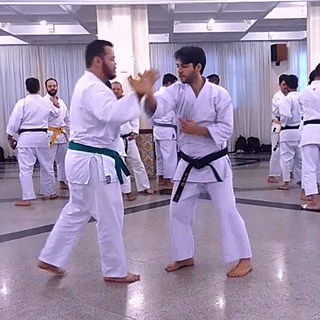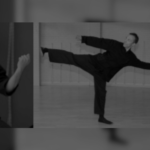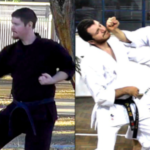Do you know kakie? Do you practice it?
Kakie カキエ is one of the extremely useful training drills of Okinawan karate, present in schools of many different lineages including those typically classified “Shurite”, “Tomarite” or “Nahate”. However, there’s a great deal of confusion, misconception and even disagreement among experient practitioners about this kind of training. I’ve been in touch with the teachings of many different lineages and views on kakie through the years, and have studied it extensively both in theory and practice, involving historical, tactical and technical (biomechanical) aspects.
Now for the sake of contributing with the community, I want to share a few important points I’ve learned about it:
- Kakie is related to kakete 掛け手 and kakedameshi 掛け試し, but each one of those concepts is a different thing.
- Kakie is not a kind of sparring or fighting, but it does involve testing oneself against a partner. It’s mainly a test of technique fundamentals and not so much of physical strength or even speed. Attacks and responses may be added to the exercise, but they’re not necessary.
- It teaches tactile sensitivity and connection; structural alignment; dynamic posture balance; energy transfer and other related technical qualities. It’s fully related to the learning of application of chinkuchi チンクチ and engagement of gamaku ガマク.
- There are a few typical “standard” kinds of kakie drills, and a great number of variations can be used to put more emphasis on specific techniques.
As mentioned above, many schools teach kakie, but the training is often different depending on the school. The points above are among the ones I found to be historically accurate and technically relevant in my own training and study journey.
Similarly to what happens to many other kinds of traditional training drills (such as kihon undou 基本運動 or even kigu hojo undou 器具補助運動), nowadays practitioners sometimes may train kakie more for the sake of repetition, but without proper understanding of the goals and benefits of the practice, and without gaining said benefits. It’s not easy to grasp how kakie should really be practiced just by watching videos, and sometimes the videos won’t represent kakie very clearly. However, kakie is an extremely beneficial kind of exercise and practitioners should study it deeply to achieve a better understanding, gain all benefits and pass them along to the students.
Kakie is an important part of the curriculum of Muidokan Karate Kenkyukai, and I teach more about it on regular classes and seminars. It adds a great deal of functional technique to practitioners interested in old style karate or self defense fighting.
What do you think of kakie? Have you practiced kakie before? Does your school’s kakie have similar traits as described above? How about the differences? Would you like to learn more about it?
Good training to all!

(São Paulo/Brazil seminar, 2019).




Pingback: ARTICLE | Kake-Kumite/Kakedameshi: The original free sparring of Karate
Pingback: Kake-Kumite/Kakedameshi: El Combate Libre Original de Karate
Pingback: Kake-Kumite/Kakedameshi: The original free sparring of Karate
Pingback: Fundamental technical concepts of old style karate – Muidokan Karate Kenkyukai